Arizona, located in the southwestern United States, is filled with incredible creatures. Many of the most dangerous live on land, but the skies above Arizona are laden with predators. Let’s discover the ten most dangerous animals patrolling Arizona’s skies.

The Most Dangerous Animals in Arizona’s Skies
Out of the most dangerous animals patrolling Arizona’s skies, only a few are dangerous to humans because they carry parasites and diseases. The rest are dangerous in regard to their prey animals.
Let’s start with the ones that pose some danger to us.
1. Mosquito
Mosquitoes. Hated by presumably every human on Earth, these buzzing insects are dangerous because they spread diseases such as Zika, dengue, and malaria. Arizona has its fair share of these biting nuisances, but one of the most concerning is Aedes aegypti, an African native that bites at dusk and dawn. Aedes aegypti is dark, small, and extremely persistent.
Experts recommend Arizonians eliminate standing water on their properties to avoid creating a breeding ground for biting mosquitoes. Empty out pots and gullies and collect rainwater because mosquitoes need water to hatch their larvae. On summer mornings and evenings, when mosquito activity levels are high, it’s best to wear insect repellent and protective clothing to deter bites.
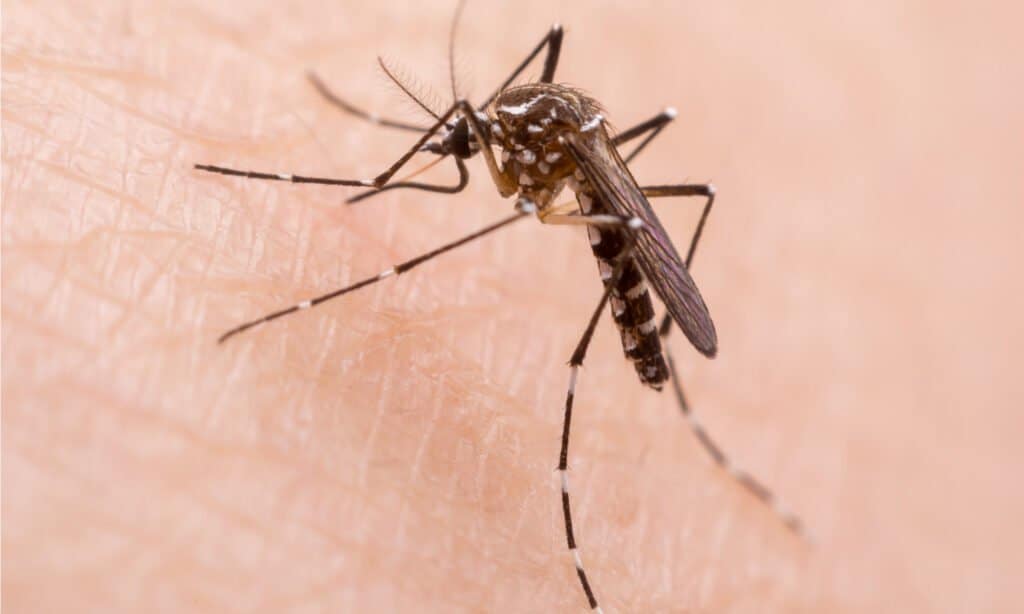
Mosquitoes occupy Arizona’s skies and carry of some of the most dangerous parasitic diseases.
©Surachai Pung/Shutterstock.com
2. Tarantula Hawk
It’s not a tarantula, and it’s not a hawk. The tarantula hawk is a wasp with an excruciating sting, and it’s found patrolling Arizona’s skies. Its name refers to its chief prey species, tarantula spiders.
This little wasp’s sting tops the Schmidt sting pain rating index. That makes it more potent than a fire ant. Rarely its sting will trigger an allergic reaction.
Tarantula hawks’ preferred environment is desert-like dry areas that attract their tarantula prey. However, this wasp does not eat tarantulas; it actually eats nectar. Unfortunate tarantulas are food for their larvae.
An adult tarantula wasp’s sting is capable of paralyzing a large spider (it’s not just tarantulas this wasp hunts down). It then drags the incapacitated arthropod to its burrow and lays an egg on it. After hatching, the larva feasts on body parts, avoiding vital organs until it pupates into an adult and bursts through the spider’s skin.
Aside from this gruesome Alien-esque way of rearing its young, tarantula wasps are beneficial to humans because they’re top pollinators. Just be sure to leave them alone to avoid an agonizing sting.
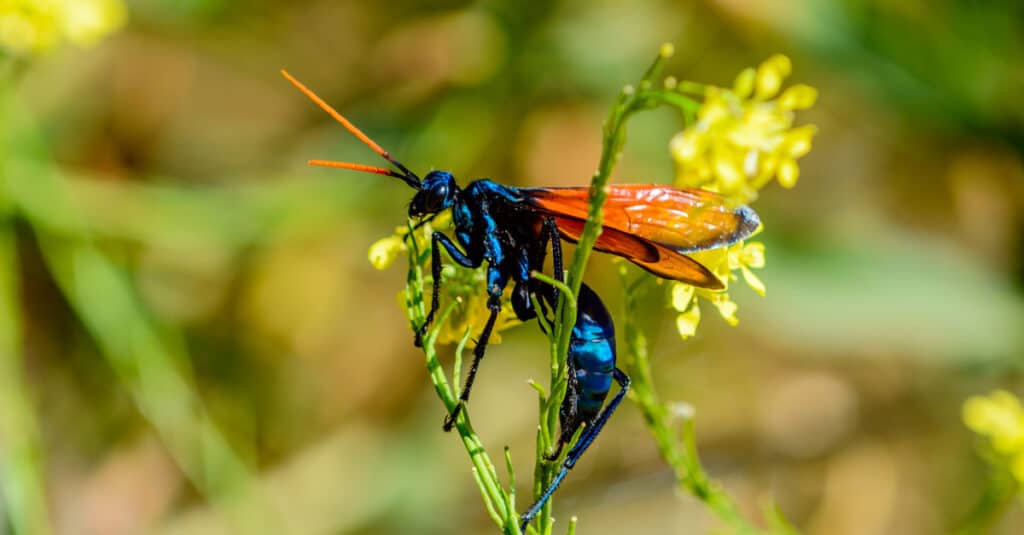
A tarantula hawk’s sting is so painful it’s ranked more agonizing than a fire ant.
©Robert Briggs/Shutterstock.com
3. Conenose Bug
Why is a conenose bug, better known as a “kissing bug,” one of the most dangerous animals patrolling Arizona’s skies? Because it’s a disease vector, and multiple bites have caused anaphylactic shock.
Cone nose bugs inject an anesthetic, so sleepers won’t know they’re under attack. Similar to bed bugs, this parasite munches on blood without waking its victim. In the morning, a small rash is visible, and aches and pains may kick in. Anyone bitten by a conenose bug should keep the area clean and seek medical attention if the area won’t heal or they feel unwell. Porch lights attract these flying bugs that enjoy our sheltered homes and closely shaded woods.
If you’re curious about the name kissing bug, it’s because they often feed from soft areas of skin like the skin around a human’s or dog’s mouth.
Sleep well!
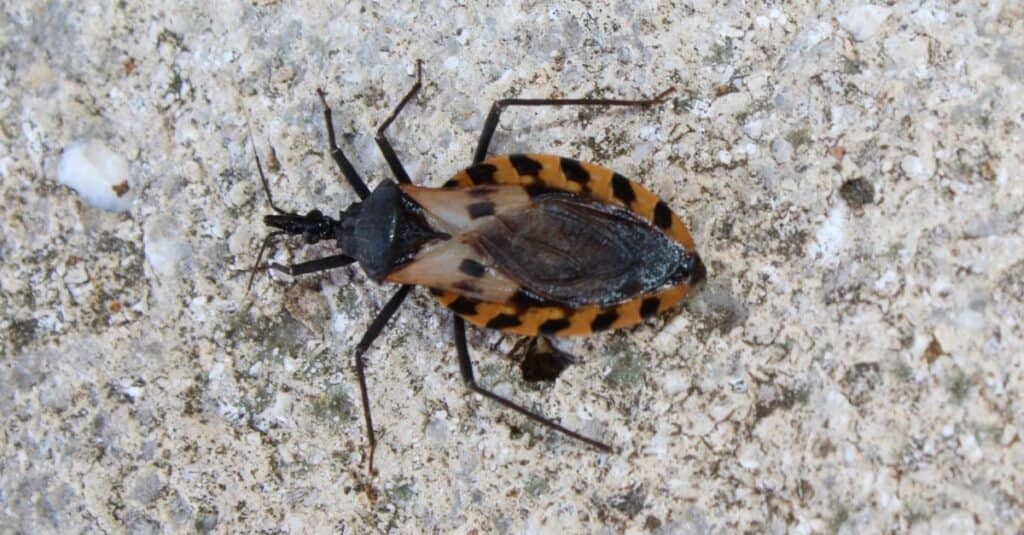
Kissing bugs get their name from biting sleeping human mouths.
©Vanessa Becker-Miller/Shutterstock.com
4. Herring Gull
Yes, that’s right, Arizona’s herring gulls are dangerous. Anyone who’s tried to eat lunch near a herring gull knows why.
Herring gulls are bold and fearless, and wield long, sharp beaks that folks call “face knives.” Their natural fish and crustacean diet is seemingly insufficient for these massive birds, whose wingspan reaches 62 inches wide. They prefer to take human food from garbage cans and sometimes directly from your hands.
Small mammals and lizards are fair game, too; in fact, a herring gull will gulp down anything small enough to swallow. Anything larger or hard, such as a clam, is smashed into a rock until it breaks into pieces. Some reports indicate herring gulls also take small pets such as rabbits, kittens, and chihuahuas.
Herring gulls live near reservoirs, lake beaches, and farmland in Arizona. They’re easy to recognize with their paper-white bodies, gray wings, and yellow beaks with webbed feet, but you’re more likely to hear their raucous laughing cry from a distance. Social birds, a herring gull will soar over Arizona’s skies, scanning for a meal, and then arrive with a group of companions. At this point, it’s best to abandon your picnic.
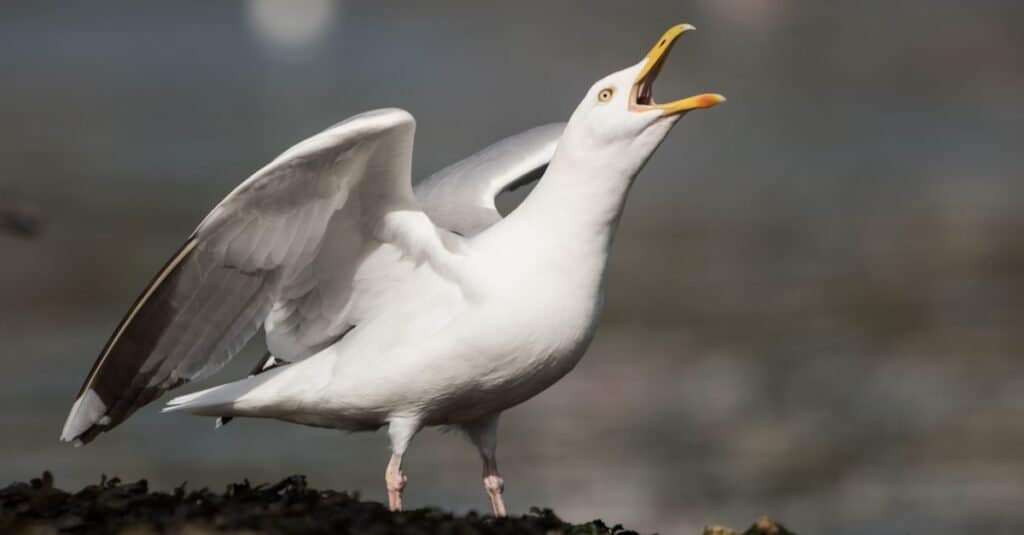
Herring gulls have razor-sharp beaks capable of dealing with large wounds.
©Maciej Olszewski/Shutterstock.com
5. Africanized Bee (Killer Bee)
It’s a name to strike fear, and it’s appropriate because killer bees can land a potentially fatal sting on animals and humans. Arizona’s skies are home to this king of bees. This insect aggressively defends its hive and isn’t afraid to sting unwelcome visitors, which contrasts with calm native garden bumblebees.
This dangerous insect is a hybrid between East African lowland honeybees and European honeybees, created because they’re prolific honey makers. However, some colonies escaped captivity in the 1950s and spread across Central and North America.
One of killer bees’ most scary aspects is their ability to chase threats over a long distance. Reports indicate they are capable of tracking victims for a quarter of a mile.
Unfortunately, they look very much like honey bees. You need to get up close to tell the difference, and that is not recommended. Killer bees have smaller bodies than a honeybee, with darker brown bands. They measure anything up to an inch long.
Africanized bees have killed horses, and reports say they’ve killed 1,000 people since their break for freedom. In Arizona, one family was rescued by firefighters who blasted the bee swarm with foam.

Killer bees are more aggressive than honey bees. They chase perceived threats for a quarter of a mile.
©Pamela Au/Shutterstock.com
6. Peregrine Falcon
Peregrine falcons patrol the skies over most of North America. This is the world’s fastest animal and is highly dangerous to its pigeon, duck, songbird, or small mammal prey. To catch prey, these incredible birds float like clouds with razor-sharp eyesight, and once a target is located, they drop into a 200 mph dive. Not much can escape a diving peregrine falcon. The fastest on record reached an epic 242 mph. Typically, a peregrine falcon aims at their prey’s limbs and grabs it before lifting it skyward because a high-impact collision at 200 mph may damage its lightweight bones.
A peregrine falcon’s preferred habitats are mountains and open plains. Arizona’s deserts and high peaks provide perfect sites for peregrine nests, called scrapes. These birds formed lifelong relationships with a mate, breeding annually and typically producing 3-4 chicks.
Arizona’s dangerous bird of prey is easy to recognize. It has a yellow hooked beak, bright yellow feet with ominous talons, and gray to brown feathers. Adults weigh, on average, 1.5 lbs, and a male’s wingspan stretches over four feet tip to tip.

A peregrine falcon can dive for pigeon or duck prey at over 200 mph.
©Harry Collins Photography/Shutterstock.com
7. Red-tailed Hawk
Red-tailed hawks patrol Arizona’s skies, targeting small mammals and reptiles such as squirrels, rabbits, rats, and snakes. Found in 49 states, it’s North America’s most widespread hawk. While it isn’t rare, it’s dangerous to any small creature on open ground. These ferocious birds will even take crustaceans from water if presented with the opportunity.
These speedy birds of prey prefer open country, plains, and woodlands, but are a common sight above Arizona’s cities, too. They hover, target prey, then plunge into a dive, pinning the creature down and tearing it with a razor-sharp beak.
Red-tailed hawks’ plumage ranges from dark brown to pale tan, but each one has a spectacular red tail.
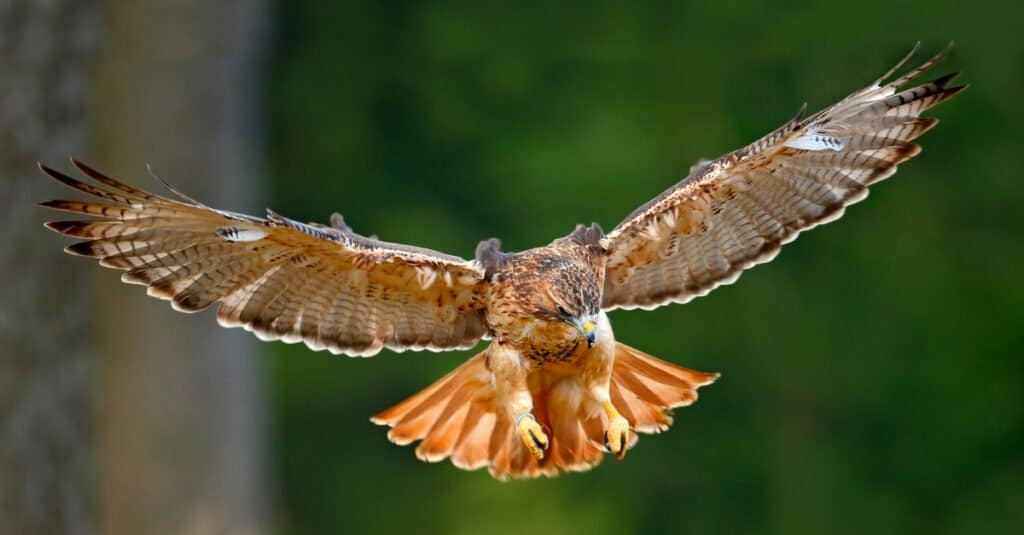
Red-tailed hawks have distinctive red tails. They’re North America’s most abundant hawk.
©Ondrej Prosicky/Shutterstock.com
8. Great Horned Owl
There’s no mistaking Arizona’s great horned owl. Its two tuft head feathers stand up like devil horns, and it carries the nickname “tiger of the air.” It’s a formidable predator, but it isn’t dangerous to humans unless you try to pick one up; in this case, it could seriously damage skin with its slicing talons and sharp beak.
Most owls hunt at night, gliding through the sky, but great horned owls go about life differently. They choose to sit tight and wait for a snake, mouse, rabbit, or toad to pass by.
This massive owl stands two feet tall with a 4.6-foot wingspan. Their three-inch long talons can apply up to 300 lb/in2 of force, more than enough to kill a small mammal. In fact, reports say these epic birds of prey even tackle porcupines.
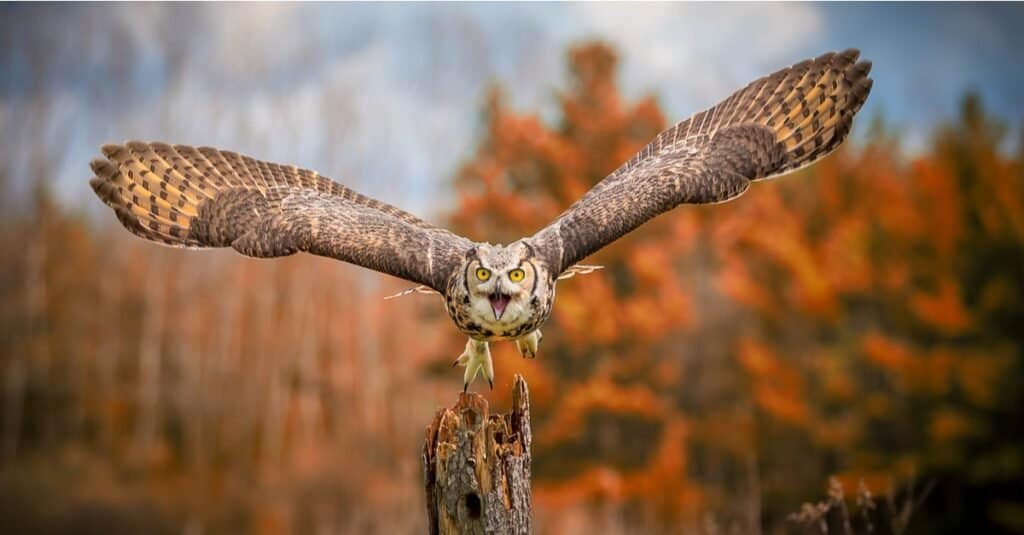
Great horned owls are ambush predators that wait for a mammal, snake, or frog to pass by.
©Imran Ashraf/Shutterstock.com
9. Botfly
Botflies do not top favorite animal lists, and they’re one of the most dangerous animals patrolling Arizona’s skies because of the infections they produce.
Botflies don’t bite, suck blood, or deliver an agonizing sting, but their reproductive habits can kill. A botfly will lay eggs on a mammal, especially drawn to wounds, and disappear. Unfortunately, those eggs hatch into maggots that develop and eat the stricken host’s flesh. Popular Arizonian bot fly targets are Sonoran desert squirrels.
These internal parasites don’t always kill their host as they eat their flesh and burst through their skin, but the resulting infection is a real problem for cattle, wildlife, and pets.
Botflies cunningly disguise themselves as bumblebees. They reach around half an inch long and have a yellow face, orange legs, and a fluffy metallic-blue hair-covered abdomen.
Their parasitic wounds weep and form rounded holes after the fly has fledged. Any Arizonian pets or livestock affected by botfly strike needs medical care.

Botflies lay eggs on mammals that hatch into flesh-eating maggots.
©AlessandraRC/Shutterstock.com
10. Pterosaur
225 to 65 million years ago, pterosaurs patrolled Arizona’s skies. The area had developed from a warm sea into a tropical region filled with dinosaurs and ancient plant life. Evidence of Arizonian pterosaurs found in the Petrified Forest is just one small toothy jaw bone, but it’s enough.
Pterosaurs were not birds but flying reptiles that preyed on animals. Experts aren’t sure exactly how they hunted, but pterosaur species evolved different equipment. Some were filter feeders, others had long pointed beaks, and some species wielded teeth. These enormous predators would have dominated Arizona’s skies no matter what species.

Pterosaurs dominated Arizona’s skies 225-65 million years ago.
©Nobu Tamura (http://spinops.blogspot.com), CC BY 3.0 <https://creativecommons.org/licenses/by/3.0>, via Wikimedia Commons – License
Discover the Most Dangerous (Deadliest!) Animals in Arizona
Most people agree that the most dangerous animals in Arizona include rattlesnakes, black widow spiders, bark scorpions, giant centipedes, and Gila monsters.
There’s also a pocket of black bears north of Phoenix and regular but rare mountain lion sightings.
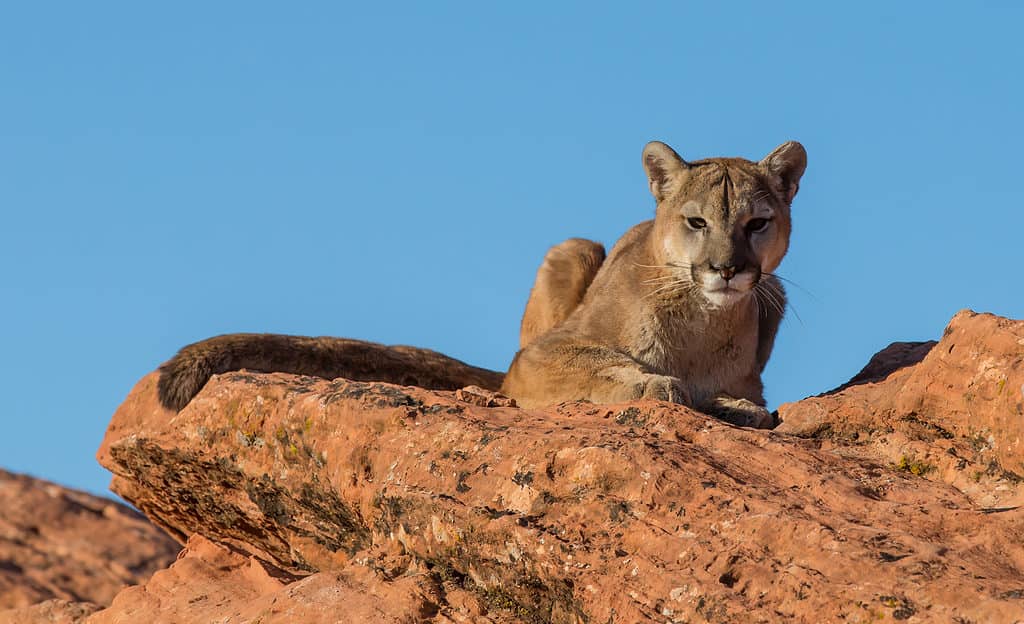
Mountain lions are rarely seen in Arizona, but reports suggest they live there.
©Warren Metcalf/Shutterstock.com
Summary of the 10 Most Dangerous Animals in Arizona’s Skies
Arizona’s skies are packed with life, including some dangerous animals. Animals that pose a danger to humans include mosquitoes, wasps, Africanized bees, conenose bugs, and hungry herring gulls. Other dangerous animals that prey species would consider dangerous include peregrine falcons, great horned owls, red-tailed hawks, and botflies.
And let’s not forget the ancient Arizonian pterosaurs, whose presence would have frightened away the vast majority of modern-day Arizonian predators – except perhaps the feisty and tenacious herring gull with a sandwich in its sights.
| Rank | Animals |
|---|---|
| 1 | Mosquito |
| 2 | Tarantula Hawk |
| 3 | Conenose Bug |
| 4 | Herring Gull |
| 5 | Africanized Bee (Killer Bee) |
| 6 | Peregrine Falcon |
| 7 | Red-tailed Hawk |
| 8 | Great Horned Owl |
| 9 | Botfly |
| 10 | Pterosaur |
The photo featured at the top of this post is © iStock.com/rancho_runner
Thank you for reading! Have some feedback for us? Contact the AZ Animals editorial team.






